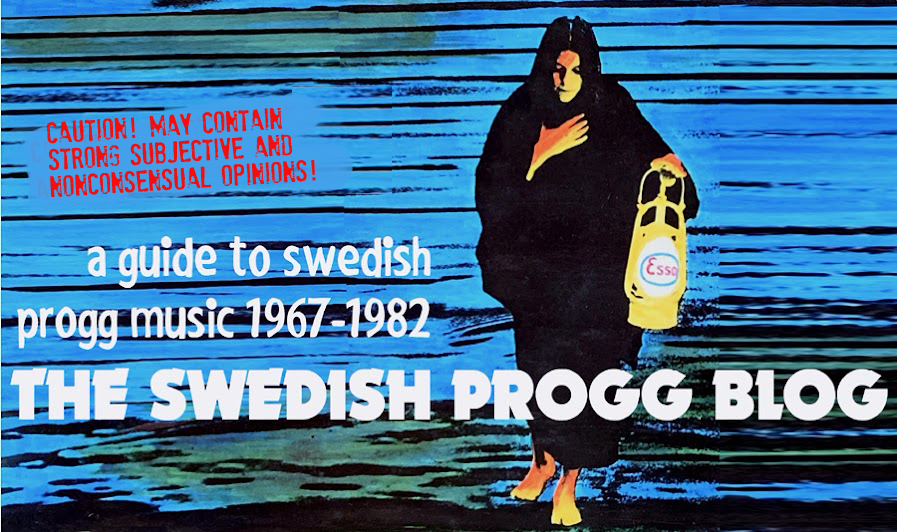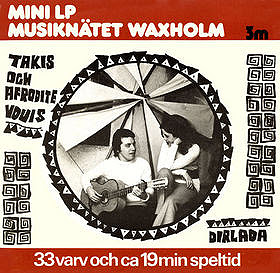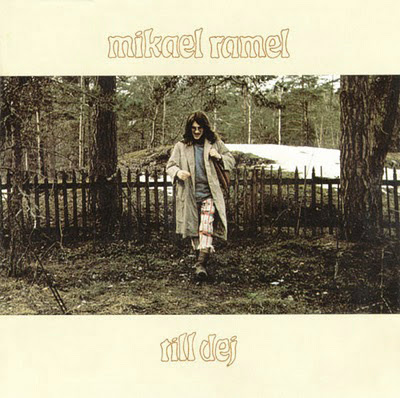International relevance: ***
Swedish vocals
Ranked #6 on the blog's Top 25 list
The major part of this review was written before the album was reissued to great acclaim. Although some of it turned dated following the re-release, I've decided to keep it the way it was originally written as it sheds some light on the discovery of the album, adding information on the reissue to the end.
Everybody loves a good mystery, and
mysteries rarely come any better, or more frustrating for that matter,
than this.
For me, it all started that day when I
was browsing Youtube for Swedish progg rarities. Most of the time,
it's the well known stuff that gets repeated outings. People who
remember their youth in the 70's share their favourite symph rock och
leftwing rememberances from their youth, with sound pictures to boot.
It's all very nice, and every once in a while you can add some
tidbits of information from folks who experienced it first hand. But
it's rare that something entirely unknown surfaces among the numerous
Youtube channels. That day, when I was digging through crates of
wellknown material, it suddenly happened.
Someone had uploaded a whole album's
worth of material by a band called Slite Cement (pronounced
slee-teh), The most amazing thing was that not only one or two tracks
by this mysterious outfit were good. They were all mindblowlingly
fantastic! One track after the other revealed a band that was better than November or Life, or any of your favourite heavy
Swedish 70's band you care to mention. How on earth could a band such
as this has remained completely unknown almost four decades? I
immediately went on a research path.
Only to throw myself into a labyrinth
of dead ends.
I began thinking that maybe this was a
hoax. The vocals were great. The guitars soared like monsters. The
sound quality was top-notch. Everything was in its perfect place.
Could this be recent day put-on by some jokers with a need to
fabrciate a myth and a ”rarity”?
The name of one of the band members was
T. Harlevi. With Harlevi being a less than common name in Sweden, I
began googling for the guy, without knowing his first name. I figured
Slite Cement came from Gotland, Sweden's biggest island, since Slite
is a small city on Gotland. Tracks lead to Visby, the main city of
Gotland, and one Thomas Harlevi, now drummer in a band called
Lampljussymfonikerna. Could it be I was on my way debunking the
mystery) I got hold of an email adress to one of the other members in
Lampljussymfonikerna. I wrote him, and waited for a reply. And
waited. And waited. And waited. Nothing happened. Obviously, it was
just another dead end.
I kept googling, and in the mean time,
I played Slite Cement to various people. All of them were surprised
by the amazing quality of the music. Some of them are progg diehards
themselves, but none of them had heard the name of the group, let
alone the group itself.
Months go by, and all of a sudden, a
short rather recent article comes my way, published in a local paper.
I learnt that Slite Cement was quite popular locally, and that they
had briefly reformed at one time. Could this be a breakthrough? I did
another hunt for members on Facebook. I emailed one Anders Åström,
but it seems that my message went unread. Given the information I
found regarding Lampskensorkstern, Thomas Harlevi was ill, so I
didn't want to bother him with his past, not knowing how he was
doing.
I tried another Facebook-search for
”Slite Cement”, and since my last hunt for the truth, a Facebook
group had been established, dedicated to the band; ”Cement
(Slite)”! Despite the slightly anomalous
name for this Facebook group, it was
obvious I had finally come to the right place. The group is
administrated by Robin Johansson, the grandson of Cement member
Björn Johansson, who sadly passed on years ago.
However, Robin couldn't help me with
more specific details, but I learnt that ”Utmaningen” was
recorded at local radio station Radio Gotland. Robin encouraged me to
in fact email Thomas Harlevi, and I had a brief reply from him,
telling me that he and bassist Stig
Hjellström were the ones who released the recordings as a cassette
tape. Then, our contact abruptly ended. According to an article
published in the late 70's, also posted in the Facebook group, the
original plan actually was releasing ”Utmaningen” on vinyl. Much
later, they made CD-R copies of the recordings (possibly only to
friends). No traces of a proper vinyl release, though. I haven't been
able to confirm how many copies were made of the original release,
but given that Slite Cement was a local act, not too many may have
been made. Perhaps Hjellström and Harlevi made all the copies at
home?
The Facebook page isn't that rich with
information on the band, but reading an old paper clipping published
in the Facebook group, the band came to life in 1973. The same
article mentions 1977, the date of the recordings, as the band's high
point, but they also say that the tracks recorded are ”tight, but
rather uneven”. (I couldn't disagree more!) Members mentioned are
Thomas Harlevi, drums; Stig Hjellström, bas; Tomas Jönsson, congas,
and Björn Jansson vocals and guitar. The articles also says that
Jansson could have used some better vocal technique, and they also
slag him for writing lyrics that are too universal. Furthermore, the
article do acknowledge Jansson's guitar playing, but adds that his
solos are too long. Anyone who listens to the album can prove the
writer wrong on all accounts.
Instrumentally, ”Utmaningen” is a
tour de force, every bit as excellent as any of the better known
heavy rock album from the Swedish 70's. Jansson is, at that, a better
singer than many of his peers, with a powerful yet not overwrought
delivery. As far as the songs go, there's not one single weak track
in this collection. Had ”Utmaningen” been released as an LP in
1977, it would have fetched four digit sums today, counting in euros
and dollars. This album is a true masterpiece!

In September 2017, German label
Shadoks graced "Utmaningen" with its first ever vinyl
edition (400 copies). The reissue
comes in a heavy duty sleeve with new cover art shown below, and is
pressed in thick vinyl. The reissue is very well done, and most
important true to the sound of the original 1977 recording. It also
comes with an insert with pics of the band and mewly written liner
notes by Tobias Petterson, author of progg bible "The
Encyclopedia of Swedish Progressive Music". Petterson sheds some
biographical light on the band, tracing their origins back to 1973
when the fledgling band (with a different line-up) rehearsed in an
abandoned girls' school in Visby, ”capital” of the Gotland island. It
wasn't until 1975 that the band took it a higher level of seriousity,
with singer and lead guitarist Björn Jonsson began showing his
extraordinary songwriting skills, coming up with songs that easily
outdid the cover songs they started out with. They played several
gigs locally, including one in support of Samla Mammas Manna.
”Utmaningen” was recorded and mixed over a weekend, with tapes of
the sessions sent to mainland record companies. Failing to secure a
proper label deal, the band issued the MC themselves in an edition
of 100 copies. The self-produced tape was sold in grocery
stores and gas stations, and cost 600 SEK to make, a hefty sum back in
the day. While the recordings were made in 1977, the cassette wasn't
released until 1980. When creative force Jonsson decided to leave, Cement disbanded soon after.
Special thanks to
drummer Thomas Harlevi for providing photos of the original tape!
Full album playlist



















